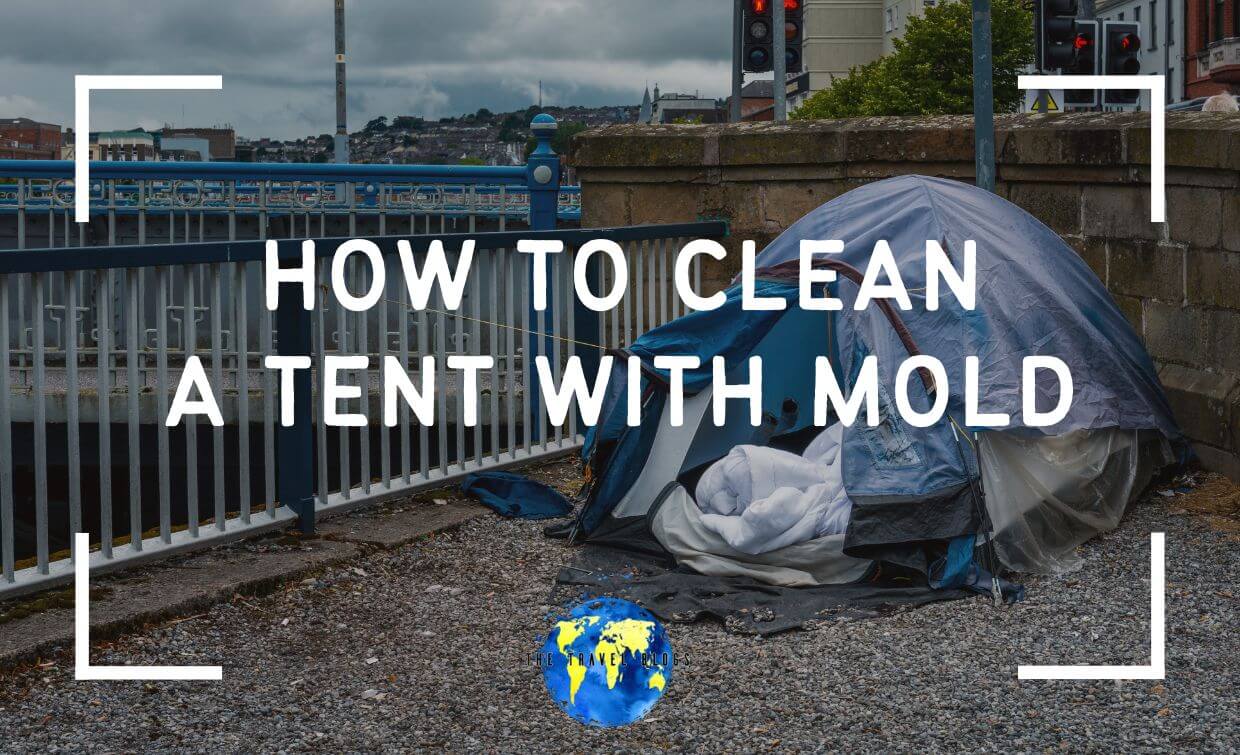A moldy tent is not only unpleasant to be in, but it also poses a health risk. Mold can cause allergic reactions and respiratory problems that may lead to serious illness. This is why it is super important to know how to clean a tent with mold and keep your camping gear in tip-top condition.
In this blog post, we will help you remove the mold from your tent by providing the steps needed to do so as well as the equipment required for this process. So roll those selves up, open a tin of elbow grease and let’s get cleaning!
Coming your way in this post - click to expand ->
Note – Please know, some of the external links on this page are affiliate links, this means that if you purchase after following one, I make a small commission from the sale at no additional cost to yourself.
How to Clean a Tent with Mold
The steps
- Prep the tent for cleaning.
- Brush off the mold.
- Spot clean dirty areas.
- Soak the tent in warm soapy water or use a commercial enzyme cleaner.
- Go over any area with dirt remaining. Note – be careful not to scrub areas with a polyurethane (PU) waterproof coating. This can damage it.
- Rinse the tent with water until you remove all the soap.
- Allow to air dry.
Note: It is important to know that you should not put your tent in a washing machine or a dryer. No matter how tempting it is, it can do irreparable damage.
What You will Need for Cleaning a Moldy Tent
- Gloves – to protect your hands from chemicals
- Water – for rinsing and soaking the tent. Warm water is preferable, but cold will work as well.
- Commercial Enzyme cleaner or warm soapy water – this will be used to soak the tent with mold on it to break down any remaining spores of fungus that may exist inside material fibers.
- Sponge or soft brush – for spot cleaning any areas that may not be washed by the water.
- Bathtub or large basin – for soaking.
- Air-drying rack or nice sunny outdoor area – for drying the tent after cleaning it.

Deep Cleaning Process
Once you have gathered your cleaning supplies, you are ready to deep clean and attack the mold and mildew.
To prep the tent for cleaning
The first step in cleaning your tent is to shake away loose debris from the outside of the fabric. For this, be sure to unzip your main door and turn your tent inside out. Give it a good shake and remove any soil, loose debris, or dead ants that may have made it home with you after your last camping adventure.
It is also wise to wipe down your tent poles (this is often forgotten). It may be that there are some spores that have made it there, and if they are not cleaned properly, it could just trigger a new patch soon after cleaning the previous one.
You may also like: How to clean a camping cot
Spot clean the dirty area
If you have areas of your tent fabric that remain dirty after shaking, maybe they have some caked-on mud, use a sponge and a drop or two of mild soap to scrub the area.
Lightly scrub your fabric walls in circular motions using just a small amount of dish soap before rinsing off
Do not use any kind of household cleaners such as bleach, spot remover, or laundry pre-soaking products as they risk leaving harmful residue on the canvas exterior of the tent which may damage its structure over time.
This is particularly important when considering the tent floor. Harsh cleaning products and over scrubbing can damage the polyurethane (PU) waterproof coatings meaning that your tent floor may let dampness it.
There are a number of homemade remedies that people recommend. Two of the most popular are distilled white vinegar or a cup of lemon juice in a spray bottle. While I’m a big fan of home cleaning hacks, when it comes to my tent, I’d rather not risk straying from the recommended products to avoid damaging the tent or invalidating a warranty.
Although, a lemon fresh scent on a camping trip may be pleasant.
Time to submerge and soak
Fill the tub with lukewarm water (don’t use hot or cold) so it’s deep enough for the bottom of your tent.
If you want to, you can add a tent cleaner product or a mild soap.
Carefully place your entire tent into the tub. If you don’t have a bathtub and are restricted by a smaller sink, submerge only one side of the fabric at once then take it out again when wet before putting in another section.
You may need to wash or agitate the stains and moldy areas with your sponge or soft bristles.

Rinse your tent
You’ll now need to remove any soap or cleaner residue. Drain the tub and refill it with fresh cold water, swishing the entire thing around until all of the soap is, gone, and repeat the step with clean water as necessary.
Dry your tent
To dry your tent after cleaning, pitch the tent in an outdoor shaded area and let it air dry completely. This may take several days, so it would be wise to check the weather forecast before starting cleaning.
Before packing it away again, ensure that is it bone dry. You should never store a tent that is still damp unless you want to spend a lot of time repeating the process above
Optional step – deodorize
Once you’ve cleaned your tent, it may still have a stubborn foul odor. Fortunately, there are odor eliminators that will take care of this problem.
You can buy a commercial odor eliminator to do this or you can make a homemade deodorizer using things like coffee grounds, dish detergent, and baking soda.

FAQs – Understanding Mold on Tents
What is Mold?
Mold is a type of fungus that grows in the form of any number of different species, all living on organic material. It can be found almost anywhere and thrives when in damp or wet conditions.
A tent that has been put into storage while still damp is the perfect condition that mold needs to grow and thrive.
Where does Mold come from?
Mold spores can come from anywhere but will almost always be established when the air is too humid. This is why it is important to store your tent in a cool, dry place. Mold on tents usually begins as patches or spots that grow larger over time, eventually discoloring the fabric and weakening its structure.
Is Mold Dangerous?
Mold can be dangerous in that spores from moldy fabrics are easily spread. These spores can cause significant respiratory problems, such as allergies and asthma. It can also lead to skin irritations and infections as well as attract insects.
How do I know if I have mold?
You will usually notice visible mold as black, green, or blue-grayish spots on the tent material. Also, a musty smell or foul odor similar to that of rotten vegetables or mildew odors is a sign that you likely have mold. When checking your tent for mold, be sure to check hard-to-reach places like seams and in the folds of the tent fly.
Is my tent mold resistant?
You can check a tent’s warranty for mold and mildew resistance. If it doesn’t mention anything about being resistant to mold, then you can assume that the fabric is not resistant.
Can I use vinegar to clean a moldy tent?
Vinegar is a natural disinfectant and also an effective mold remover. You can use vinegar to clean a moldy tent by mixing equal parts water and white distilled vinegar in your spray bottle, then spraying generously onto the offending area until you have sprayed all over every inch of that spot. Let sit for five minutes, scrub with a soft-bristle toothbrush or sponge if necessary.
However, to be safe, try a small test area before using it on the whole tent. Also, be sure it won’t invalidate the warranty.
What can you do to get rid of the mold and smell?
The easiest and most effective way to tackle moldy smells is with a homemade deodorizer. You can use things like coffee grounds, dish detergent, and baking soda in an empty container or jar. Shake the mixture periodically to help it work more efficiently.
Alternatively, you can buy special deodorizing products that are made just for outdoor gear. These products will usually come with a specific set of instructions, so be sure to read them before using them on your tent or sleeping bag.
How do I prevent future mold growth in my tent?
The best way to prevent mold in your tent is to ensure it is stored properly. If you tend to only go on occasional short camping trips, it can be easy to negate this point but make sure it clean and completely dry before packing away and store it in a cool, dry place. Never store wet tents or wet fabrics.
Conclusion
Camping is great fun, but no one likes a dirty tent, especially when preparing for long camping trips.
If you don’t clean it properly, mold and mildew will grow on the inside of your tent walls. This can cause irreparable damage to expensive camping gear or even worse, make you sick. That’s why it is vital to clean your tent regularly and take steps to prevent mold.
I hope this guide has helped you to understand how to remove mold from your tent and outdoor gear as well as understand the importance of keeping your tent clean, bone dry and fresh between trips. This ensures the longevity of your tent and many adventures for years to come!
You may also like:
